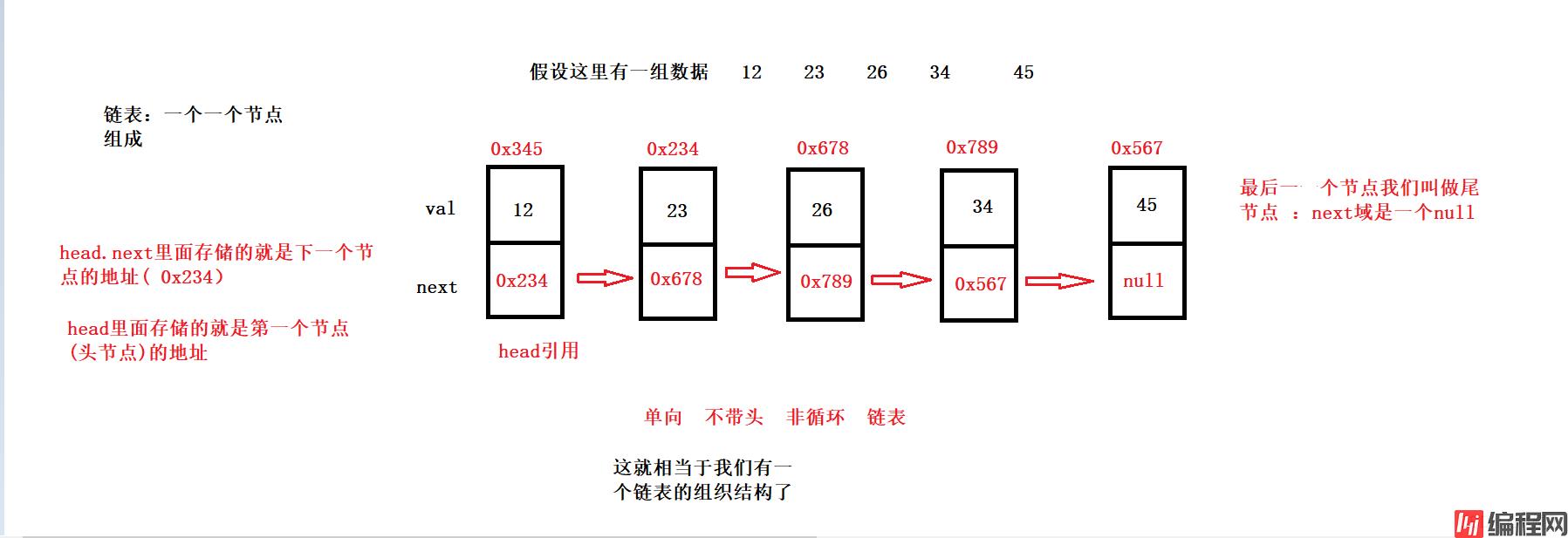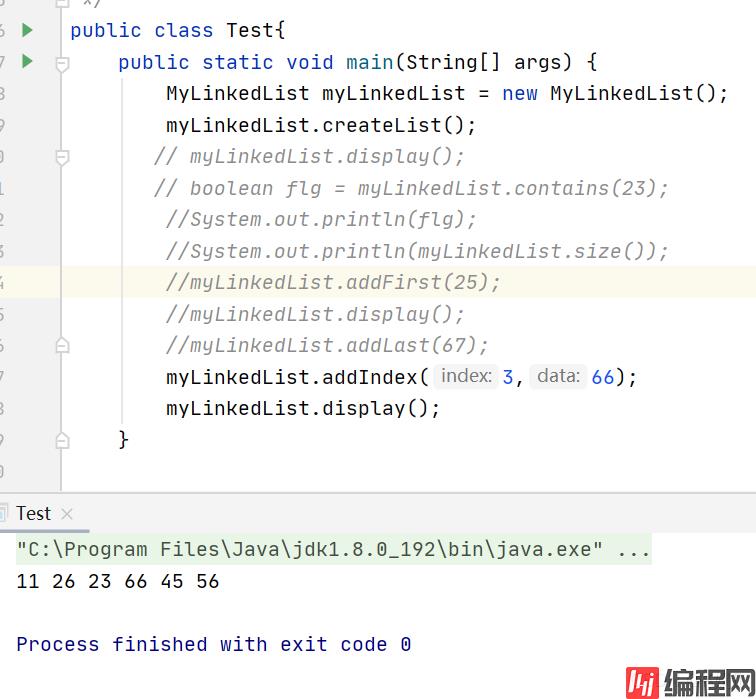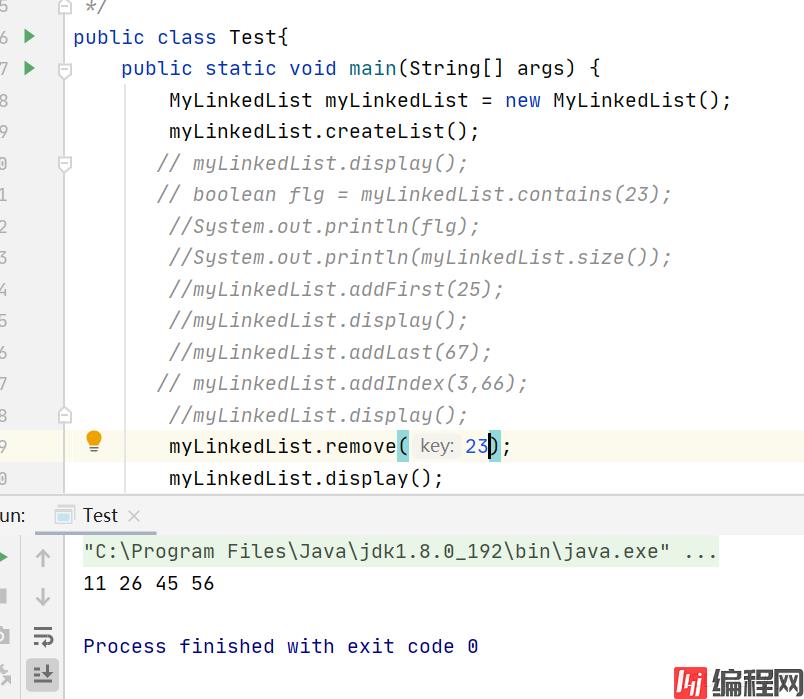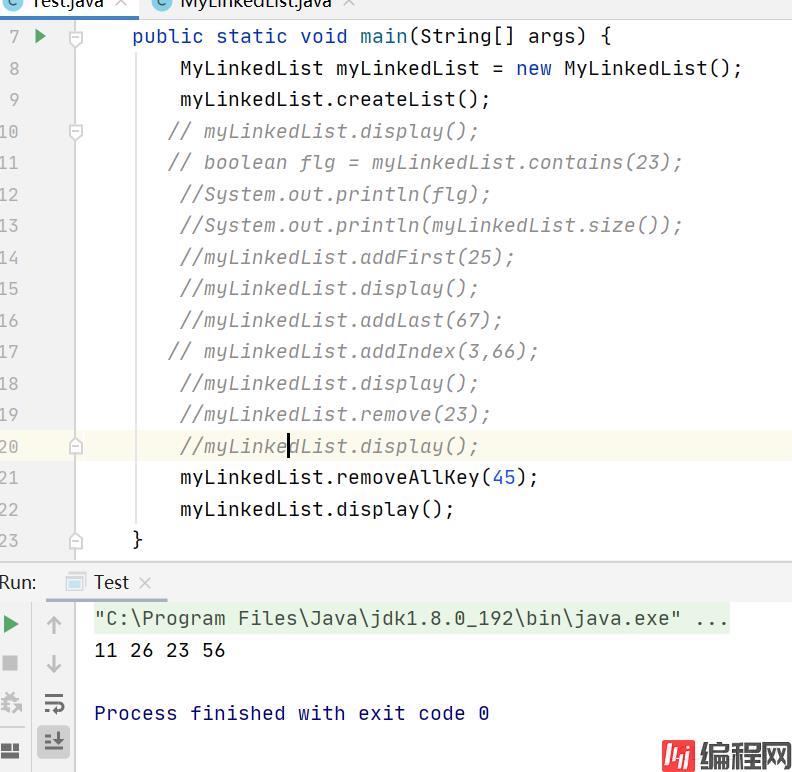Python 官方文档:入门教程 => 点击学习
目录前言:一、什么是链表链表的概念链表的结构链表如何存储数据链表的实现 穷举法创建链表打印链表查找是否包含关键字key是否在单链表当中 得到单链表的长度:头插法尾插法任意位置插入,
顺序表的问题及思考
1. 顺序表中间/头部的插入删除,时间复杂度为O(N)
2. 增容需要申请新空间,拷贝数据,释放旧空间。会有不小的消耗。
3. 增容一般是呈2倍的增长,势必会有一定的空间浪费。例如当前容量为100,满了以后增容到200,我们再继续 插入了5个数据,后面没有数据插入了,那么就浪费了95个数据空间。
思考: 如何解决以上问题呢?下面给出了链表的结构来看看。
链表是一种物理存储结构上非连续存储结构,数据元素的逻辑顺序是通过链表中的引用链接次序实现的 。
链表结构分为8种:

这里我们只讲最下面两种,因为在工作中、业务里、考试题、刷到的链表题、面试题里面都是用到这两种链表。
链表是由一个一个节点组成的。(这里我们以单链表为例)
什么叫做节点?
节点分为两个域 ,假设一个叫做val域,一个叫做next域。
val:数据域
next:下一个节点的地址

//Listnode代表一个节点
class ListNode{
public int val;
public ListNode next;
//构造方法
public ListNode(int val){
this.val = val;
}
}
//MyLinkedList 代表这是一个链表
public class MyLinkedList {
public ListNode head;//链表的头引用,所以定义在链表里,head是链表的头,不是节点的头,节点只有两个属性,一个属性是val值,一个属性是next值,所以不能定义在ListNode类里面
ListNode listNode = new ListNode(2);//节点实例化,val域赋值为2
}
/MyLinkedList 代表这是一个链表
public class MyLinkedList {
public ListNode head;//链表的头引用,所以定义在链表里
public void createList(){
ListNode listNode0 = new ListNode(11);
ListNode listNode1 = new ListNode(26);
ListNode listNode2 = new ListNode(23);
ListNode listNode3 = new ListNode(45);
ListNode listNode4 = new ListNode(56);
listNode0.next = listNode1;
listNode1.next = listNode2;
listNode2.next = listNode3;
listNode3.next = listNode4;
this.head = listNode0;
}
//打印链表
public void display(){
ListNode cur = this.head;
while (cur != null){
System.out.print(cur.val+" ");
cur = cur.next;
}
System.out.println();
}打印结果:

//查找是否包含关键字key是否在单链表当中
public boolean contains(int key) {
ListNode cur = this.head;
while (cur != null) {
if (cur.val == key) {
return true;
}
cur = cur.next;
}
return false;
}打印结果:

//得到单链表的长度
public int size(){
ListNode cur = this.head;
int count = 0;
while(cur != null){
count++;
cur = cur.next;
}
return count;
}打印结果:

//头插法
public void addFirst(int data) {
ListNode node = new ListNode(data);
if (this.head == null) {
this.head = node;
} else {
node.next = this.head;
head = node;
}
}打印结果:

//尾插法
public void addLast(int data){
ListNode node = new ListNode(data);
ListNode cur = this.head;
if(this.head == null){
this.head = node;
}else {
while(cur.next != null){
cur = cur.next;
}
cur.next = node;
}
}打印结果:

public ListNode findIndex(int index){
ListNode cur = this.head;
while(index -1 != 0){
cur = cur.next;
index--;
}
return cur;
}
//任意位置插入,第一个数据节点为0号下标
public void addIndex(int index,int data){
if(index < 0 || index > size()){
System.out.println("位置不合法");
return;
}
if(index == 0){
addFirst(data);
return;
}
if(index == size()){
addLast(data);
return;
}
ListNode cur = findIndex(index);
ListNode node = new ListNode(data);
node.next = cur.next;
cur.next = node;
}打印结果:

//删除第一次出现关键字为key的节点
public void remove(int key){
if(this.head == null){
System.out.println("没有你要删除的节");
return;
}
if (this.head.val == key){
this.head = this.head.next;
return;
}
ListNode cur = this.head;
while (cur.next != null){
if(cur.next.val == key){
cur.next = cur.next.next;
return;
}
cur = cur.next;
}
if(cur.next == null){
System.out.println("没有该节点");
return;
}
}打印结果:

//删除所有值为key的节点
public ListNode removeAllKey(int key){
if(this.head == null) return null;
ListNode prev = this.head;
ListNode cur = this.head;
while (cur != null){
if(cur.val == key){
prev.next = cur.next;
cur = cur.next;
}else{
prev = cur;
cur = cur.next;
}
}
if(this.head.val == key){
this.head = this.head.next;
}
return this.head;
}打印结果:

本文简单介绍了数据结构的链表,如何创建链表,链表上如何操作数据。通过简单例题的方式加深对顺序表的理解。上述就是今天的内容,有任何疑问的话可以随时私信我,文章哪里出现了问题我都会积极改正,也希望大家能更快的掌握自己想要的知识,让我们一起加油!!!!!
到此这篇关于Java 精炼解读数据结构的链表的概念与实现的文章就介绍到这了,更多相关Java 数据结构的链表内容请搜索编程网以前的文章或继续浏览下面的相关文章希望大家以后多多支持编程网!
--结束END--
本文标题: Java 精炼解读数据结构的链表的概念与实现
本文链接: https://lsjlt.com/news/142459.html(转载时请注明来源链接)
有问题或投稿请发送至: 邮箱/279061341@qq.com QQ/279061341
2024-03-01
2024-03-01
2024-03-01
2024-02-29
2024-02-29
2024-02-29
2024-02-29
2024-02-29
2024-02-29
2024-02-29
回答
回答
回答
回答
回答
回答
回答
回答
回答
回答
0